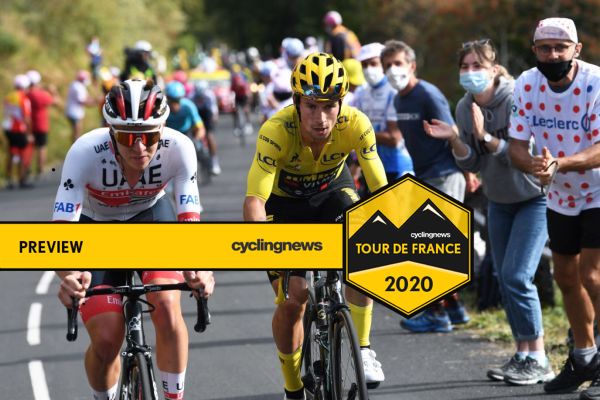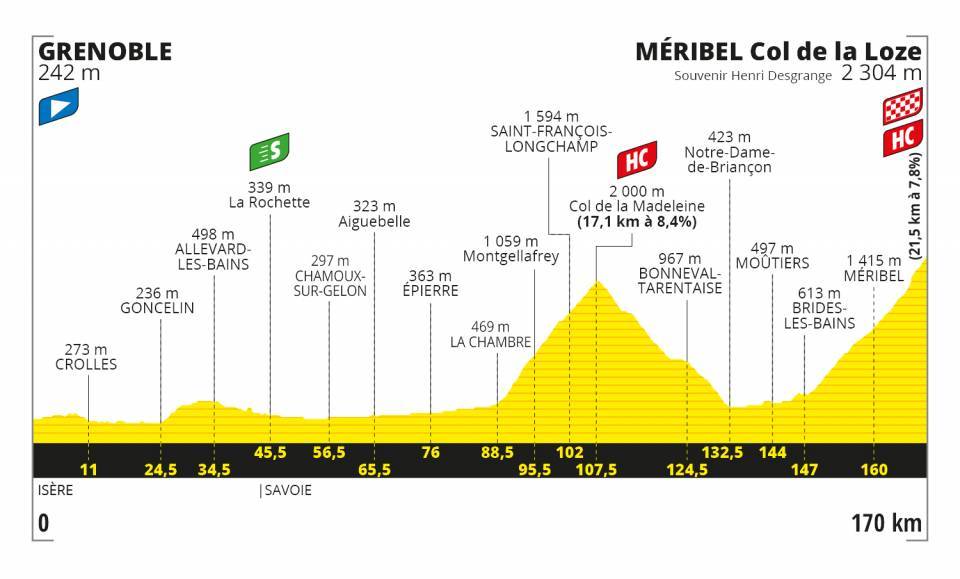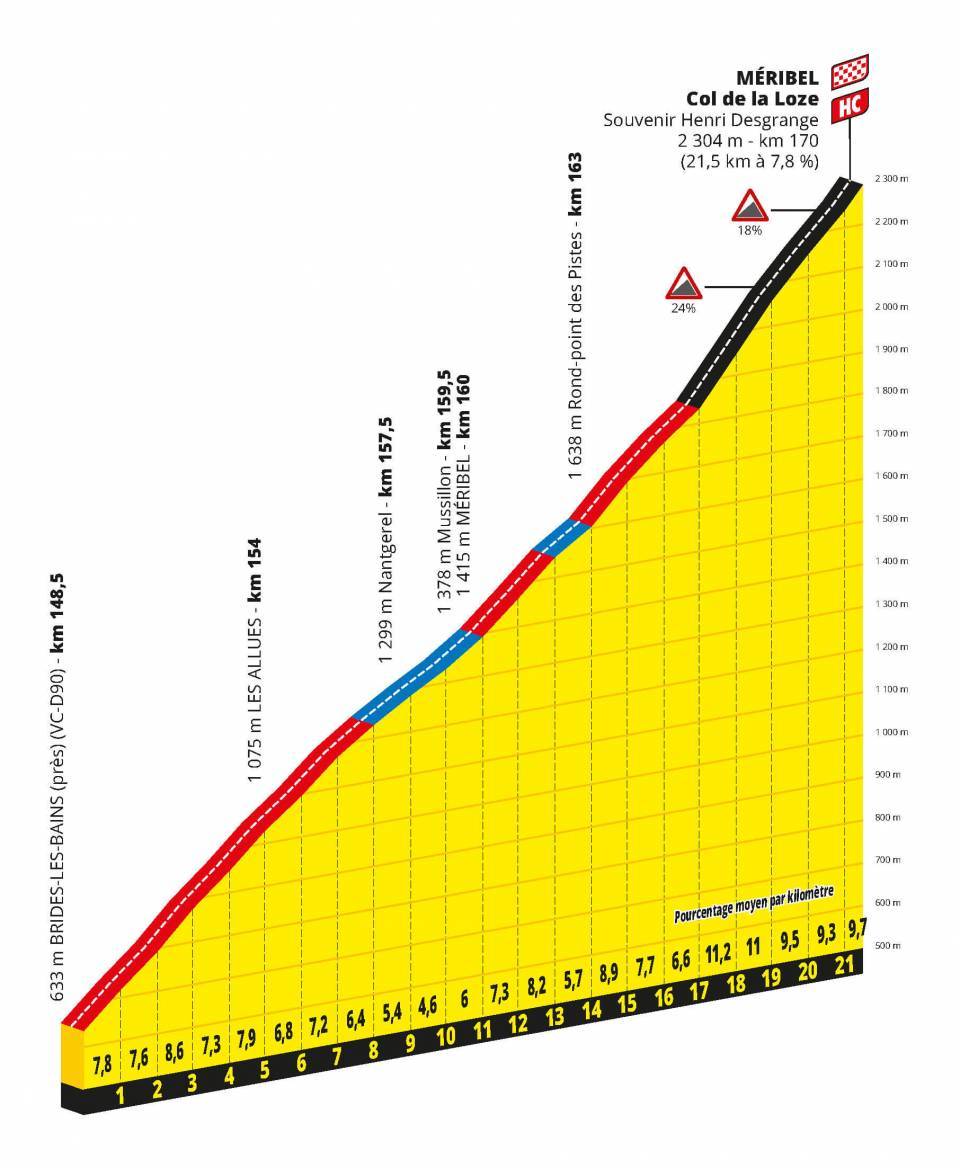Tour de France fireworks expected on spectacular Col de la Loze – Preview
All-new bike path with 'series of walls' to play host to high-altitude summit finish

The first day in the Alps on Tuesday, in the final week of this Tour de France, was a quiet day for the overall contenders, but there'll be no place to hide on the spectacular Col de la Loze for stage 17 on Wednesday – the first instalment in back-to-back stages that will define this race before the penultimate-day time trial has the final say.
While Thursday's stage, with climbs from start to finish, seems set for one of those madcap days of racing where anything could happen at any moment, Wednesday has a much clearer focal point: it's 21.5 kilometres long and rises to 2,304 metres above sea level.
Even the venerable Col de la Madeleine, jutting up just past the half-way point, does little to divert the gaze. That's partly due to the figures and to its position at the very end of the stage, but it's also due to its novelty; the Col de la Loze is not only new to the Tour, but new to the world.
It's a traffic-free cycle-path of a high-mountain pass, built only last year to connect Méribel and Courchevel. Previously, it was only possible to ride and drive up to the altiports that lie a few kilometres above each of the two ski resorts, but the local authorities have completed an ambitious project to pave seven-kilometre bike paths on either side of the mountain's peak.
Barely four metres wide, with gradients that at times touch 24 per cent, it was always, quite understandably, the most highly anticipated point of this year's Tour.
It's quite unlike anything that's found in the Alps – a region with awe-inspiring peaks, but with a sort of default setting of roads built as access to ski resorts, with pretty regular gradients of around six or seven per cent. That's exactly what the first 11 kilometres are, from Brides-les-Bains in the valley to the centre of Méribel at 1,415m. Four more kilometres take you to the altiport, but suddenly the Loze path begins and everything changes.
There are hairpins, and there are longer straight sections, but above all there are nasty ramps that jut up almost vertiginously. This is far beyond the more irregular gradients found in the Pyrenees, and race director Christian Prudhomme has spoken of "a series of walls". He even name-dropped the Mur de Huy – the ultra-steep climb used at the end of Flèche Wallonne.
Get The Leadout Newsletter
The latest race content, interviews, features, reviews and expert buying guides, direct to your inbox!
"You go around a hairpin, and you're coming up to a 'wall', but you're on a false flat – it's a continual changing of rhythm," Prudhomme said. "It's going to be an incredible finale because we've never had that kind of breaking-up of gradient, at that altitude. It doesn't exist – or it didn't, until now."
As such, comparisons with previous visits to Méribel are somewhat redundant – not that there are many. The only time it has hosted a finish was way back in 1973, when Bernard Thévénet won a split stage at the altiport, although the Critérium du Dauphiné went to the resort in 2016, when Thibaut Pinot got the better of Romain Bardet.
There is, however, a precedent for the Col de la Loze, as it was first trialled on the under-23 peloton at last year's Tour de l'Avenir. Remarkably, the climb was the stage – a 23km mass-start rush from Brides-les-Bains to the summit, some 1,691 metres above. Australia's Alexander Evans won that day as Tobias Foss, finishing fifth at 42 seconds, took the yellow jersey from future Deceuninck-QuickStep rider Mauri Vansevenant.
That stage was filmed in parts, and the footage shows just how savage some of the inclines are. Vansevenant, considered one of the brightest talents, was reduced to slaloming across the road in a desperate bid to ease the gradient.
Altitude
One key factor that makes the Col de la Loze all the more enticing are the words 'Souvenir Henri Desgrange' you can see just below it on the stage profile. That means it's the highest point in this year's Tour de France, with an award for the first rider to reach it – in this case the stage winner.
In contrast to the 2019 Tour, which was billed as one of the 'highest' in history, the 2020 edition, despite its proliferation of climbing, doesn't actually take in much altitude. Much is made of the '2,000-metre barrier, and this will be the first and only time we break it.
The Col de la Madeleine is listed as 2,000 metres exactly, but is said to actually be a slightly less glamorous 1,993m. Even so, the Loze, at 2,304m, takes us very much into the 'extreme'; it's the seventh-highest mountain pass in the whole of France.
In theory, that would give a natural advantage to the so-called 'altitude natives'. Even if Egan Bernal and Nairo Quintana have fallen away, fellow Colombians Rigoberto Urán and Miguel Angel López – born at 1,800m and 2,800m, respectively – sit third and fourth overall, while the two Slovenians at the top of the standings, Primož Roglič and Tadej Pogačar, were both born at less than 500m. However, the proliferation of altitude training in modern cycling has somewhat levelled the playing field.
Still, the oxygen debt effectively leaves nowhere to hide; the strongest will rise to the top and any weaknesses will be exposed.

Roglic vs Pogacar?
After Egan Bernal's dramatic capitulation on the Grand Colombier on Sunday, the 2020 Tour de France appears something of a two-horse race, despite five other riders still being little over two minutes down. That’s not to do a disservice to Urán, López, Adam Yates, Richie Porte and Mikel Landa – or even Enric Mas at 3:15 – but the scintillating debutant Tadej Pogačar, at 40 seconds, has so far been the only rider who has been capable of doing any damage whatsoever to yellow jersey Primož Roglič.
Even if Pogačar's attacking instincts are being hyped up, the severity of the Col de la Loze means that he and the others are likely to save their bullets for it, rather than trying anything as far out as the Col de la Madeleine. Coming 62km from the line, and followed by a long descent plus 15km in the valley, it would take someone to put their race on the line to go from there. Most of the top 10 wouldn't, and Pogačar doesn't really need to.
Instead, after a big battle for both the breakaway and the intermediate sprint after 45.5km, we can expect Jumbo-Visma to set the tempo on the Madeleine. The route takes the harder of the two ways up, from the south – last used in 2013 – meaning an average gradient of 8.4 per cent over 17.1km. It may not be the major flashpoint but it's still an hors-catégorie beast of a climb, and it won't be a peloton that goes over the top, but more of a 'yellow jersey group'. They'll then descent the northern side of the Madeleine that has often been tackled en route to Alpe d'Huez, before 15km of false flat in the valley.
The final climb starts out in a quite straightforward fashion, with 15km of fairly regular Alpine ascending. Going by what we've seen so far, Jumbo-Visma are likely to impose their rhythm here, and the rest will be content to let them do so. Once the bike path starts, however, all bets are off.

What's certain is that Jumbo-Visma won't be able to ride that part like the Grand Colombier, given the simple physical fact that slipstreaming counts for next to nothing on gradients like that. Tom Dumoulin was commanding on the Grand Colombier, but this is much less his sort of terrain, and he will surely be used up further down the climb, leaving the featherweight Sepp Kuss as the last man with Roglič. On current form, you could see him being there most of the way up.
It's hard to see any other contenders having teammates with them by that point, and it's likely to be a case of every man for himself, each clawing their way to the line in a sort of survival of the fittest. As such, pacing will be all-important, as Clément Champoussin, who attacked it like a maniac in the Tour de l'Avenir, found out. When you go into the red on those gradients, at that altitude, you can pay dearly.
In a Tour that has been relatively tight so far, the Col de la Loze is widely expected to do a lot of damage in a very short space of time. Pogačar is flying and ought to thrive on this terrain, while Roglič has looked utterly unflappable up to this point. It's set to be an enthralling contest.
Beyond those two, Urán faces a big test of his podium credentials after an understated but assured start that brings back memories of 2017, while López just behind him has looked sharp. Yates came here for stage wins but is now all-in for GC, while Landa hasn't done much wrong apart from miss that echelon on stage 7. All are more or less out-and-out climbers who prefer changes in rhythm over steady grinding ascents. However, a real podium contender could emerge in Porte, currently sixth at 2:13. He was the one able to go after Roglič and Pogačar on the steep finish at Puy Mary, and split the group to four with an acceleration on the top of the Grand Colombier.
Still, as Prudhomme pointed out, it's difficult to predict how it'll play out, given we've never really had anything like this at the Tour. Anything could happen, and whatever does happen, it's sure to be spectacular.
Patrick is a freelance sports writer and editor. He’s an NCTJ-accredited journalist with a bachelor’s degree in modern languages (French and Spanish). Patrick worked full-time at Cyclingnews for eight years between 2015 and 2023, latterly as Deputy Editor.
